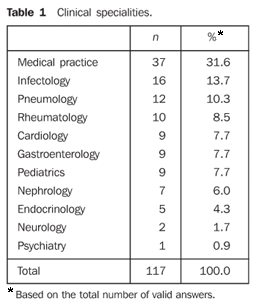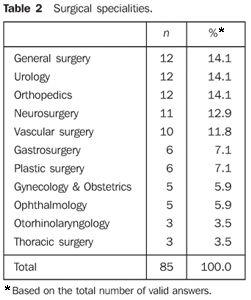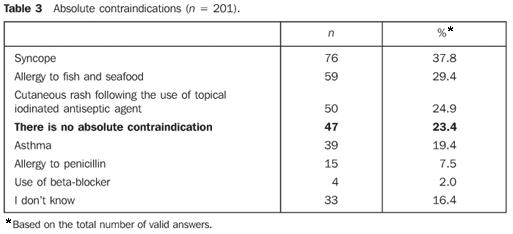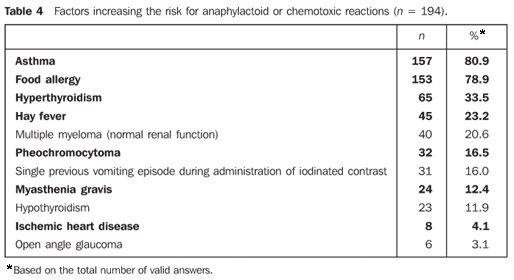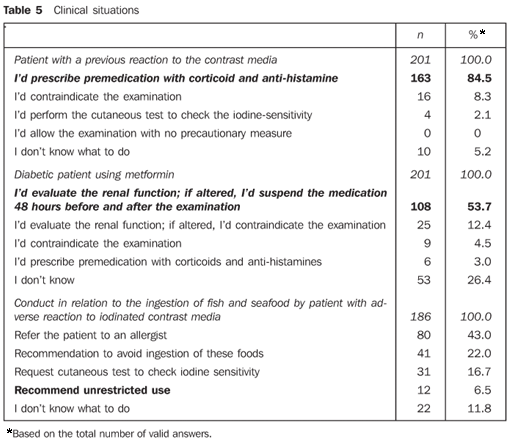Radiologia Brasileira - Publicação Científica Oficial do Colégio Brasileiro de Radiologia
AMB - Associação Médica Brasileira CNA - Comissão Nacional de Acreditação
 Vol. 40 nº 5 - Sep. / Oct. of 2007
Vol. 40 nº 5 - Sep. / Oct. of 2007
|
ORIGINAL ARTICLE
|
|
Evaluation of nonradiologist physicians' knowledge about adverse reactions to iodinated contrast media |
|
|
Autho(rs): Ronald Trindade, Daniel Vaccaro Sumi, Wagner Luiz Kravetz, Paulo Eduardo Codello Rebelo, Fabíola Fontana, Cássio Gomes dos Reis Jr. |
|
|
Keywords: Iodinated contrast media, Radiology, Adverse reactions, Risk factors |
|
|
Abstract:
INTRODUCTION Intravenous iodinated contrast media have gained a significant role as a diagnostic adjuvant. With the increasing utilization of these agents, they have undergone a remarkable development paralleling the progress of different imaging methods. Despite this progress, with increasingly safe contrast agents, adverse reactions may occur in up to 12% of patients, the greatest majority of such reaction being of mild nature. However, reactions considered as severe or very severe correspond to 0.26% of the total number of adverse reactions(1). Additionally, the development of acute contrastinduced renal failure occurs in up to 10% of patients, and is the third cause for renal dysfunction in the hospital setting(2,3). In the spectrum of reactions related to the utilization of intravenous contrast media, there are some clinical conditions associated with their higher incidence, as well as a wide range of precautionary measures that must be adopted both previously and after contrast-enhanced procedures in order to provide safety for the patient and efficacy in the diagnosis. On the other hand, many myths still survive, particularly among practitioners not involved with radiology, impairing the diagnostic accuracy of imaging methods. The present study was aimed at evaluating nonradiologist physicians' knowledge about adverse reactions to intravenous iodinated contrast media, covering clinical conditions associated with the increase in the risk for these reactions, as well as measures related to their prevention, diagnosis and treatment.
MATERIALS AND METHODS A prevalence study developed during October/2005, including 203 medical residents, trainees, and assistants at Hospital do Servidor Público Estadual (HSPE) de São Paulo, SP, Brazil. Each of the physicians included in the present study anonymously answered a questionnaire consisting of ten multiple-choice questions approaching several aspects related to risk factors, necessity of premedication, and contraindications for the use of intravenous iodinated contrast media. The first question approached clinical conditions that would represent absolute contraindications for the use of iodinated contrast media. The second question involved risk factor for the development of anaphylactoid or chemotoxic reactions. Other three questions presented clinical situations frequently occurring in the daily medical practice, related to the use of iodinated contrast media in diabetic patients taking metformin, patients with previous history of reaction to contrast media, and patients with history of allergy to fish and seafood. Three assertive, true-or-false-type questions approached contrast-induced nephropathy and risk factor for the development of adverse reactions. Also, open questions as regards demographics, asking the respondents about their specialities, time of professional practice and frequency of contrast-enhanced studies ordering in their practice. The software SPSS (Statistic Package for Social Sciences) for Windows®, version 12.0 was utilized for statistical analysis of data in the present study. Questions whose answers were left blank, or with more than one alternative marked where not allowed, were invalidated and therefore excluded for the purpose of statistical analysis. The results were expressed in mean ± standard deviation for interval or ratio variables, or in proportions for nominal or ordinal variables. The non-parametric Mann-Whitney test was utilized for comparison between interval or ratio variables. The proportion analysis was carried out by the chi-square test (c2), the Fisher's exact test, or Yates' correction for continuity, as indicated. The differences found with chance probability < 5% (p < 0.05) were considered as statistically significant.
RESULTS In a total of 203 physicians participating in this study, 118 (58.4%) were identified as residents or trainees, and 84 (41.6%), as assistant physicians (one of the participants did not identify his occupational status), divided into several clinical and surgical specialities (Tables 1 and 2). Mean time of medical practice was 10.5 years, ranging between 10 months and 44 years.
As regards the frequency of contrast-enhanced studies ordering in their daily practice, 21 (10.3%) respondents said that they does not order any, while 171 (84.3%) indicate that they order up to five contrast-enhanced studies per week, and 11 (5.4%), more than five per week. The physicians were asked about absolute contraindications and, as observed on Table 3, 47 (23.4%) answered correctly, saying that there is no absolute contraindication to contrast media injection. There was no difference in the number of correct answers between assistant physicians and residents, clinicians and surgeons, or as regards contrast-enhanced studies ordering (p > 0.05).
Table 4 demonstrates the physicians' view on clinical conditions increasing the risk for adverse reactions to contrast media. Asthma (157; 77.3%) and food allergy (153; 74.5%) were most frequently indicated as risk factors. Only eight (3.9%) correctly indicated heart ischemic disease as a risk situation. A statistically significant difference was found between residents and assistant physicians as regards the identification of some risk factors. Only seven (8.8%) correctly identified pheochromocytoma, in comparison with the 25 residents (22.1%) (c2 = 6.057; p = 0.014). As regards myeloma in patients with renal dysfunction, 11 (13.8%) assistant physicians, and 29 (25.7%) residents indicated this condition as a risk factor (c2 = 4.046; p = 0.044). In questions regarding thyroid function, 65 respondents, represented by 16 (20%) assistant physicians and 49 (43.4%) residents (c2 = 11.446; p = 0.001) correctly indicated hyperthyroidism as a risk factor. On the other hand, as regards hypothyroidism which does not represent a risk factor, almost all of the assistant physicians (n = 78; 97.5%) gave correct answers, as compared with 92 (81.4%) residents (c2 = 11.544; p = 0.001). When the specialities are taken into consideration (clinical × surgical), a statistically significant difference was found only in two situations. In one of them, a single vomiting episode was erroneously attributed as a risk factor by 20 (20.4%) clinicians, and by only eight (9.8%) surgeons (c2 = 3.856; p = 0.05). Open angle glaucoma, that does not constitute a risk factor for adverse reaction to iodinated contrast media, was erroneously mentioned by six (5.4%) clinicians and no surgeon (Fisher's exact test, p = 0.04). The frequency of contrast-enhanced studies ordering did not affect the identification of risk factors for adverse reactions.
Table 5 shows simulated clinical situations frequently generating doubts when a patient is referred for contrast-enhanced studies. In the first situation, as regards patients with a previous history of reaction to contrast media, the majority of respondents (n = 163; 84.5%) correctly answered that they would prescribe premedication with corticoid and antihistamine agents. In the second situation, as regards diabetic patients taking metformin, the majority of respondents (n = 108; 53.7%) correctly answered that the best conduct would be to evaluate the renal function, and, in case of abnormality, interrupt the use of antihyperglycemic agents for 48 hours previously and after the examination. In this question, a statistically significant difference was observed as regards correct answers of as sistant physicians (n = 38; 45.2%) and residents (n = 70; 59.8%) (c2 = 3.856; p = 0.05). In another question regarding ingestion of fish and seafood by patients with a previous history of adverse reaction to contrast media, only 12 (6.5%) would recommend the unrestricted use of these foods. As regards the other questions, there was no statistically significant difference between answers from assistant physicians and residents, clinical or surgical specialities, or in relation to frequency of contrast-enhanced studies ordering (p > 0.05).
Table 6 illustrates the results from assertive or true-or-false type questions. The majority of respondents (n = 174; 86.1%) agreed that dehydration constitutes the main risk factor for contrastinduced nephropathy, so a patient must be hydrated previously to the contrast-enhanced examination. Ninety two respondents (45%) were wrong answering that the use of topical antiseptic agents including iodine in their formulation is contraindicated in patients with previous history of adverse reaction to contrast media. Only 12 (5.9%) correctly answered that anxious patients present high probability of developing adverse reactions to iodinated contrast media. In these questions, there was no statistically significant difference between answers from assistant physicians and residents, clinicians and surgeons (c2).
DISCUSSION Iodinated contrast media have gained an essential role as diagnostic adjuvants, particularly in large-sized hospitals with great availability of clinical and surgical resources. Despite the constant development, with increasingly safe of (nonionic, hypo-osmolar) contrast agents providing higher tolerability with lower rate of adverse reactions related to their use, there are some factors increasing the risk for occurrence of such reactions. A minimum knowledge is expected from requesting physicians so they can recognize main clinical situations associated with adverse reactions related to iodinated contrast agents to avoid such events providing patients with a safe and accurate diagnosis. In the present study, an investigation was initiated in search of contraindications to contrast media injection. According to the results of such investigation, only 23.4% of the sample answered correctly that there is no absolute contraindication. Many myths still remain concerning this matter, considering that many respondents indicated syncope (37.8%) and seafood allergy (29.8%) as absolute contraindications. A similar result was observed by Confino-Cohen & Goldberg(4) in a study including radiologists and nonradiologist physicians where 23% of respondents answered that there is no absolute contraindication to contrast media. Additionally, the authors observed a higher rate of statistically significant, correct answers among radiologists. In a similar study developed in Israel by Konen et al.(5), 203 nonradiologist physicians have participated in an investigation concerning risk factors associated with the utilization of iodinated contrast media. Results similar to the ones of the present study were found as regards some clinical conditions, such as asthma and severe food allergy pointed out as risk factors by 81.3% and 77.8% of respondents. These two conditions constitute the main risk factors related to adverse reactions and the literature reports up to 19.7% of adverse reactions in relation to asthma and up to 23% in patients who report multiple food allergies(1). With the arrival of nonionic contrast media, there has been a significant decrease in the incidence of adverse reactions, achieving up to 7.7% in patients with asthma, and up to 5.7% in allergic patients(1). On the other hand, an amazing agreement in relation to the ignorance of some risk factors, considering that only 9.8% of the sample in the Israeli study, and 4.1% of the respondents in the present study noticed the increased risk for severe adverse reaction in patients affected by heart disease that may achieve up to 0.53% in procedures involving the use of ionic contrast agents, and 0.10% in cases where nonionic contrast media are utilized(1). Additionally, it is important to note that there are some rare clinical conditions, other which still remain controversial in the literature, or some that have presented a significant decrease in the rate of adverse reactions with the arrival of nonionic iodinated contrast media. Patients with pheochromocytoma may present an unpredictable increase in the serum catecholamine level right after the intravenous contrast media injection. In the present study, about 16.5% of respondents pointed out this clinical condition as a risk factor, with a statistically significant difference between answers from residents and assistant physicians, the first ones with a higher rate of correct answers (p = 0.014). In a study developed by Konen et al.(5), pheochromocytoma has been pointed out as a risk factor by 30% of the sample. Despite the minimum risk with the utilization of nonionic contrast media, the previous administration of a-adrenergic blocker is recommended for every patient with suspected pheochromocytoma is recommended(6). There are some reports in the literature about cases of exacerbation of clinical manifestations in patients with myasthenia gravis independently from the contrast media utilized(7,8). In the sample of the present study, 12% of respondents identified myasthenia gravis as a risk factor, as compared with 28.6% in the study developed by Konen et al.(5). Another controversial factor among physicians who request contrast-enhanced studies approached by both studies is concerned with the single vomiting episode that, by no means, is related to adverse reactions to iodinated contrast media, but was pointed out as a risk factor by 63.5% of the sample in the Israeli study, and only by 16% of respondents in the present study. A statistically significant difference was observed in this topic between answers in one of the subgroups (clinicians and surgeons), with a higher number of surgeons not indicating this condition as a risk factor (p = 0.04). According to several studies in the literature, contrast-enhanced studies can be performed with a relative safety and low risk for contrast-induced nephrotoxicity in patients with a normal renal function, even if they have a multiple myeloma or are diabetic taking metformin(9-12). In the present study, 20.6% of respondents pointed out multiple myeloma as a risk factor in patients with a normal renal function. Equivocally, in the study developed by Konen et al.(5), 58% of the sample have answered positively in this item. The use of metformin by diabetic patients also was approached in the present study. Metformin is an oral antihyperglycemic agent, with approximately 90% of the absorbed drug being eliminated via renal route, so it may accumulate in the organism of patients with impaired renal function. In diabetic patients with impaired renal function, contrast media may potentially cause renal dysfunction that, on its turn, leads to metformin accumulation. The antihyperglycemic agent accumulation may lead to the development of severe lactic acidosis, a life-threatening condition in up to 50% of patients(13-15). Therefore, in these cases, the use of this drug should be interrupted 48 hours before and 48 hours after the contrast-enhanced study. The majority of respondents (53.7%) agreed that a previous evaluation of the renal function is necessary, and, in case of alteration, the use of the drug must interrupted for a safe contrast agent administration. In this item, residents achieved a higher rate of correct answers as compared with assistant physicians. Also, as regards renal function assessment, the great majority (86.1%) of the respondents in the present study indicated dehydration as one of the main risk factors for the development of acute renal dysfunction induced by iodinated contrast media, so a previous hydration of the patient becomes necessary. Despite this relatively reasonable awareness, one can observe that, not always, requesting physicians pay attention to the patient's renal function, and many times they do not inform the creatinine serum levels, do not submit the patient to an appropriate hydration, or even do not correlate diabetes and use of metformin with renal function and utilization of iodinated contrast media. Additionally, the present study approached the premedication in patients under increased risk for development of anaphylactoid reactions, particularly in those patients with a previous history of reaction to contrast media. In our sample, 84.5% of respondents correctly recommended the use of corticoid and anti-histamine in these patients. In these cases, the scheme to be utilized was not approached, because there is already a standard protocol establishing prednisone (50 mg, 13 hours, seven hours and one hour before the examination), and promethazine (intramuscular, one hour before the examination). In the study developed by Confino-Cohen & Goldberg(4), 64% of respondents also have suggested premedication associated with the utilization of hypo-osmolar contrast agent indicated by 25% of radiologists and 4% of nonradiologist physicians (p < 0.001). The type of contrast agent was not approached in the present study since the contrast medium routinely utilized in our institution is the nonionic, hypo-osmolar ioversol (Optiray®). The association between iodinated contrast medium and substances including iodine in their composition was suggested in two studies developed in the seventies. Witten et al.(16) have observed an incidence of up to 6% of acute adverse reactions in patients submitted to examinations with the use of intravenous iodinated contrast agents. Similar results were found in a study developed by Shehadi(17). However, most recent publications do not confirm such findings, concluding that a previous history of allergy to seafood or any other iodine-based product like topical antiseptic agents had no predictive value for adverse reactions to contrast media(18,19). However, this concept is still adopted nowadays by a great number of nonradiologist physicians. In the present study, only 6.5% of respondents would not recommend the restriction of seafood ingestion in cases of patients with previous history of reaction to iodinated contrast agent, while the great majority of them would refer the patient to an allergist (43.0%), would recommend avoiding such foods (22.0%) or would perform a cutaneous test to assess the iodine sensitivity (16.7%). As regards topical iodinated antiseptic agents, 45.5% of the physicians would avoid its utilization in these patients. In the study developed by Confino-Cohen & Goldberg(4), the greatest part of the sample studied (69.0%) would adopt a series of irrelevant precautionary measures as regards the use of food and antiseptic agents containing iodine in patients with a previous history of adverse reaction to iodinated contrast media. Only 18% of radiologists, and 12% of clinicians and surgeons participating in that study would correctly recommend the unrestricted use of these products. The current American College of Radiology recommendation is that only patients with a previous history of severe allergy to any substance should be included in a risk group, not approaching specifically seafood or topical iodinated antiseptic agents(20). The speciality (clinical or surgical) did not seem to influence the physicians awareness. In the hospital were the present study was developed, physicians of the different specialities requested contrast-enhanced studies with a similar frequency, so justifying the similarity in the number of correct answers to the questionnaire. Surprisingly, a long time of professional practice, contrarily to the study developed by Confino-Cohen & Goldberg(4), did not seem to be a determining factor in the level of knowledge on contrast media, because the number of correct answers of residents was higher than the number of correct answers of assistant physicians. In the medical practice, it may be observed that in academic hospitals, the complementary examinations requisition is usually decided by means of interdisciplinary discussions involving specialists, residents and trainees. However, almost always, it is the resident who is directly in contact with the department of radiology, and is responsible for answering a questionnaire informing if the patient presents risk factors for adverse reactions. Therefore, this situation may justify a higher number of correct answers from the part of residents in comparison with assistant physicians.
CONCLUSION The sample of the present study demonstrated a reasonable knowledge on contrast media, correctly identifying the majority of risk factors related to adverse reactions. Some equivocal and even mythical concepts still persist as regards iodinated contrast media and risk factors related to adverse reactions, as well as specific or controversial situations reported in the literature, which may be confusing. Such situations should be individualized, and integration and communication among radiologists and requesting physicians are necessary aiming at the optimization and safety in contrast-enhanced studies.
REFERENCES 1.Katayama H, Yamaguchi K, Kozuka T, Takashima T, Seez P, Matsuura K. Adverse reactions to ionic and nonionic contrast media. A report from the Japanese Committee on the Safety of Contrast Media. Radiology 1990;175:621–628. [ ] 2.Morcos SK. Contrast media-induced nephrotoxicity – questions and answers. Br J Radiol 1998; 71:357–365. [ ] 3.Morcos SK, Thomsen HS, Webb JA. Contrast-media-induced nephrotoxicity: a consensus report. Contrast Media Safety Committee, European Society of Urogenital Radiology (ESUR). Eur Radiol 1999;9:1602–1613. [ ] 4.Confino-Cohen R, Goldberg A. Safe administration of contrast media: what do physicians know? Ann Allergy Asthma Immunol 2004;93:166–170. [ ] 5.Konen E, Konen O, Katz M, Levy Y, Rozenman J, Hertz M. Are referring clinicians aware of patients at risk from intravenous injection of iodinated contrast media? Clin Radiol 2002;57:132–135. [ ] 6.Mukherjee JJ, Peppercorn PD, Reznek RH, et al. Pheochromocytoma: effect of nonionic contrast medium in CT on circulating catecholamine levels. Radiology 1997;202:227–231. [ ] 7.Chagnac Y, Hadani M, Goldhammer Y. Myasthenic crisis after intravenous administration of iodinated contrast agent. Neurology 1985;35: 1219–1220. [ ] 8.Rocha M de S, Bacheschi LA. Exacerbation of myasthenia gravis by contrast media. AJR Am J Roentgenol 1994;162:997. [ ] 9.Parfrey PS, Griffiths SM, Barrett BJ, et al. Contrast material-induced renal failure in patients with diabetes mellitus, renal insufficiency, or both. A prospective controlled study. N Engl J Med 1989;320:143–149. [ ] 10.Thomsen HS, Morcos SK. Contrast media and metformin: guidelines to diminish the risk of lactic acidosis in non-insulin-dependent diabetics after administration of contrast media. ESUR Contrast Media Safety Committee. Eur Radiol 1999;9:738–740. [ ] 11.McCartney MM, Gilbert FJ, Murchison LE, Pearson D, McHardy K, Murray AD. Metformin and contrast media – a dangerous combination? Clin Radiol 1999;54:29–33. [ ] 12.McCarthy CS, Becker JA. Multiple myeloma and contrast media. Radiology 1992;183:519–521. [ ] 13.Assan R, Heuclin C, Ganeval D, Bismuth C, George J, Girard JR. Metformin-induced lactic sacidosis in the presence of acute renal failure. Diabetologia 1977;13:211–217. [ ] 14.Gan SC, Barr J, Arieff AI, Pearl RG. Biguanide-associated lactic acidosis. Case report and review of the literature. Arch Intern Med 1992;152:2333–2336. [ ] 15.Gowardman JR, Havill J. Fatal metformin induced lactic acidosis: case report. N Z Med J 1995;108:230–231. [ ] 16.Witten DM, Hirsch FD, Hartman GW. Acute reactions to urographic contrast medium: incidence, clinical characteristics and relationship to history of hipersensitivity states. Am J Roentgenol Radium Ther Nucl Med 1973;119:832–840. [ ] 17.Shehadi WH. Adverse reactions to intravascularly administered contrast media. A comprehensive study based on a prospective survey. Am J Roentgenol Radium Ther Nucl Med 1975;124: 145–152. [ ] 18.Goss JE, Chambers CE, Heupler FA Jr. Systemic anaphylactoid reactions to iodinated contrast media during cardiac catheterization procedures: guidelines for prevention, diagnosis, and treatment. Laboratory Performance Standards Committee of the Society for Cardiac Angiography and Interventions. Cathet Cardiovasc Diagn 1995;34: 99–104. [ ] 19.Lang DM, Alpern MB, Visintainer PF, Smith ST. Increased risk for anaphylactoid reaction from contrast media in patients on beta-adrenergic blockers or with asthma. Ann Intern Med 1991; 115:270–276. [ ] 20.Committee on Drugs and Contrast Media, Commission on Education. American College of Radiology. Manual on iodinated contrast media. [ ]
Received February 4, 2007. Accepted after revision April 16, 2007.
* Study developed in the Service of Radiologia at Hospital do Servidor Público Estadual de São Paulo "Francisco Morato de Oliveira" (HSPE-FMO), São Paulo, SP, Brazil. |
|
Av. Paulista, 37 - 7° andar - Conj. 71 - CEP 01311-902 - São Paulo - SP - Brazil - Phone: (11) 3372-4544 - Fax: (11) 3372-4554
